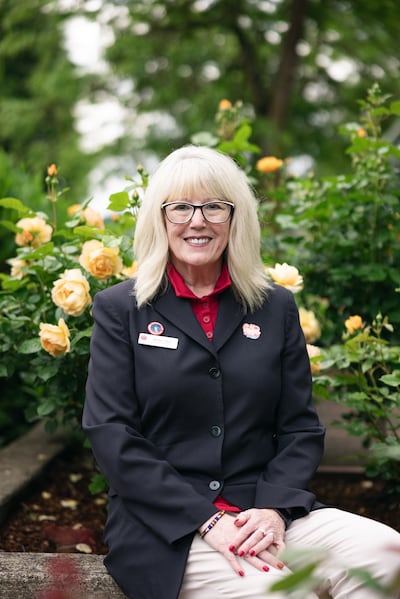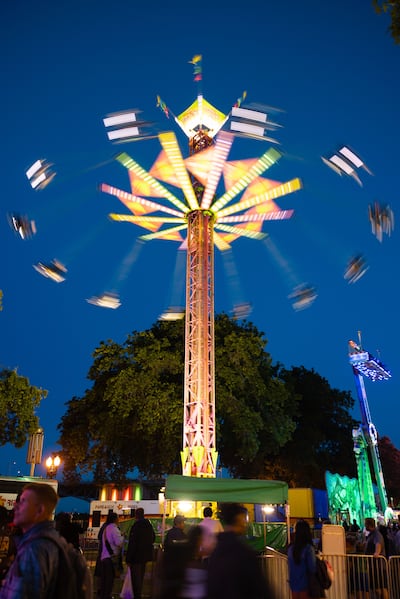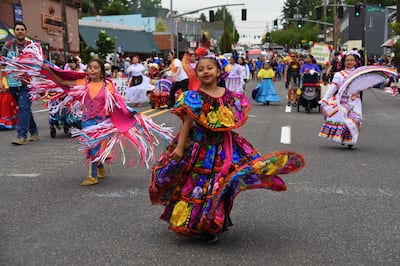How do you measure a 50-year career at the Portland Rose Festival? In princesses? In parades? In awards from the International Festivals & Events Association?
CEO Marilyn Clint counts it in corndogs.
“I’m a great corndog lover,” she says. “I start on opening day and usually get one, or even two or three in that day, and go from there.”
The morning of April 2 marked Clint’s 50th anniversary of working at the Rose Festival, starting as a seasonal secretary and working her way up to the top slot. Colleagues decorated her office with tinsel and a gold “congratulations” banner. A life-size cardboard cutout of Clint at the Grand Floral Parade in the ’90s, walkie-talkie and corn dog in hand, stood in the corner.
The Rose Festival Grand Floral Parade, happening this Saturday, June 7, is but one of three parades during the three-week festival, which marks its arrival each spring with opening-night fireworks and CityFair’s Ferris wheel at the west end of the Morrison Bridge.
This will be Clint’s last Rose Festival, and it might be one of Portland’s last, too.

In 2023, Clint told WW: “If I weren’t optimistic, I wouldn’t be sitting here. But if we’re still losing $700,000 a year, we’ll be out of business in three years.”
The quote makes Clint cringe to this day, though she stands behind her math, which has only gotten worse since then. In 2024, the Rose Festival lost $1.1 million, the largest deficit in the festival’s history.
Clint and her team have cut $800,000 in expenses to try to stay afloat. The festival has $1 million in its rainy-day fund, she says. But the finance committee has budgeted for a $300,000 loss in 2025, so back-of-an-envelope math says it’s got about three years left, without major changes.
When asked if the Rose Festival is in danger of folding, though, Clint waves this idea away with a flick of her wrist and a jangle of her “Shift Happens” bracelet.
“Oh my God. We’ve been going out of business so many times. The first time was 1912.” (Organizers saved the festival with a commemorative coin fundraiser.)
On April 2, Clint and her team were heading into “lineup day,” when they write all of the floats, bands, cheerleaders and clowns marching in the Grand Floral Parade on color-coded index cards and put them in order on a big conference room table. You can’t have a loud brass band right behind an equestrian group because the noise spooks the horses. You can’t cram all of the crowd-pleasers (the floral floats, the One More Time Around Again Marching Band) together.
Clint managed the Grand Floral from 1987 until 2000—she knows all of this. There must be a narrative arc, even if the average paradegoer can’t see it.
“What we do is layered. It is theater,” she says.
It is also a relic of a time when the majority of the city came out to tape off their annual parade-watching sidewalk spots (banned: 2008; too many fights) to watch the Grand Floral Parade, rain or shine. Today, the parade is almost exactly half of what it used to be, both in distance and attendance. Sponsorships are hard to come by and expenses are up. The organization has broadened the princess pool to include juniors and high schools as far-flung as Hillsboro, Clackamas and Tigard in order to fill out the court.

The problems are myriad, but they boil down to this: The Rose Festival is a three-week festival of mostly free events with only one meaningful economic engine, CityFair.
But what happens if the Rose Festival ends?
Some Portlanders would shrug, having always felt confused or weirded out by the Royal Rosarians or the beauty-pageant feel of the court, or just having no need to spend a Saturday sitting on a sidewalk watching it all go by.
But others would deeply grieve the 118-year-old tradition and identifying marker of our city and the inability to pass it down to the next generation. Over the course of two months, we interviewed about two dozen people in and out of the Rose Festival organization to understand what it would mean to Portland if this rose stops blooming.
This weekend, Clint and her team are making a big play to hopefully turn the festival around. At the loud request of many longtime Portlanders, the mayor, and the economic development agency Prosper Portland, they are finally moving the Grand Floral Parade back downtown.
At an early spring press conference at Travel Portland’s Visitor Center in downtown’s West End, Mayor Keith Wilson stood at a lectern to announce that he had made good on his campaign promise.

“It’s really a proud moment for me to be before you today and welcome the Rose Festival back to downtown where it should be,” he said. “For the last few years, the parade has taken a different route on the eastside. But as we look to the future, it’s time to bring this grand celebration back to the heart of our city, to bring us all back to the city.”
Wilson’s political victory is a personal one. His first childhood memory is of sitting on a blanket along the Grand Floral parade route, eating sandwiches with his family. His sister Connie was once Roosevelt High’s princess.
Prosper Portland gave the Rose Festival a one-time $100,000 grant to bring the parade back downtown. Even with last year’s diminished attendance of 225,000, the parade brought in over $8.2 million to the city, according to Prosper—a welcome boost to Portland’s downtown core that suffered a dystopian few years starting in 2020.
The new 2-mile route of the Grand Floral starts near CityFair on Southwest Naito Parkway, winds through downtown and disbands near Providence Park. It’s a vetted path, the one the CareOregon Starlight Parade has followed for the past few years. It also means no renting out Veterans Memorial Coliseum, a venue that the parade has used as a starting point since 1961 but saves $55,000 by avoiding.
But to what degree is the Rose Festival enough of a draw to get people back downtown? This has always been something of a hurdle, such as in the 1990s when the public started calling the then-Fun Center the “Scum Center” and the festival had to pivot and rebrand it as Festival Center. We now know it as CityFair.
On a cloudy Sunday morning during the opening weekend of CityFair, a healthy line starts to form at the ticket booth as it opens for business at noon on May 25. One of the first entrants to the midway is Anna Jones-Hughes, a 29-year-old Portlander who brought her 16-year-old cousin to ride the rides. She’s a first-timer.
“I always see this from afar but have never actually been,” Jones-Hughes says. “Downtown is getting a little less freaky, so I’m feeling more at ease coming down here. I’ve lived here for six years, so it’s time.”

The view of the “Vertigo” swings ride through the oak trees is not enough to convince 30-year-old Erron Smith and a friend, though, to pony up the $15 admission. They had planned to have a “cute” afternoon on the midway, but “now that we’re here, we, like, kinda just want to go home.” The extent of Smith’s Rose Festival involvement before today was getting caught in the Starlight Parade by accident in 2018. They left.
A more die-hard Rose Festival duo walked up to the line. Jon Lien and his 10-year-old daughter, Dizzy, come every year together, mostly for the games and the Ferris wheel. The finances make sense—Jon is a U.S. Coast Guard veteran and gets free admission, as did Dizzy until she turned 7. The Liens always attend the Fred Meyer Junior Parade, which runs near their Northeast Portland home, and usually hit either the Starlight or Grand Floral, too. Rose Festival is a way to mark time, the way daffodils mean Easter and football means cozy sweaters.
“It’s, like, summer is just around the corner, right? School will be over soon,” Jon says.
The Rose Festival started in 1907 as a way to brand our fledgling city as the “summer capital of the world.” There were fewer than 200,000 people living in Portland at the time and very few competing entertainment options: no big concerts swinging through Moda Center; no Portland Trail Blazers or Timbers or Thorns; no Waterfront Blues Festival; and certainly no bottomless social media scrolls keeping us home.
The Rose Festival, in its current iteration, includes the following: opening night fireworks; CityFair, rides and concerts on the waterfront; a court of 14 princesses and one Queen of Rosaria; a junior parade for children; an evening Starlight Parade; and the grande dame of it all, the Grand Floral Parade. There’s also a “wine walk,” a 5k race, the U.S. Navy’s Fleet Week, dragon boat races, and milk carton boat races.
Most of this collapses if it rains.
“It used to be the only thing we struggled with was the weather,” Clint says. “I’m sure it wasn’t; that’s in hindsight. But it certainly was a thing when it came to ticket sales.”
It still is. When it rains during the festival, attendance plummets and some events need to move inside. But the last two festivals have enjoyed glorious weather—Mother Nature has been kind to 2025 so far, too—and the organization continues to struggle. According to the Rose Festival Foundation’s 990 tax filings, it brought in $3.8 million in revenue in 2023 but had $4.4 million in expenses, a $600,000 loss. Then, in 2024, it posted the $1.1 million deficit. (2022 is sitting pretty on paper with $2 million in net income, but that’s because of an infusion of pandemic relief funds that have since dried up.)

To put that all in context, a $100,000 loss for most of Clint’s 50-year career would have been a terrible year, she says.
As recently as the early 2000s, the Grand Floral attracted 500,000 spectators. In 2024, that number was down to 225,000. Expenses are up 30% to 40% since before the pandemic for things like city fees and rentals for fencing and porta-potties.
Meanwhile, sponsorship has fallen off along with attendance: Spirit Mountain Casino declined to renew its sponsorship of the Grand Floral in 2023 after more than a dozen years in the title spot, as did Portland General Electric, which was actually the first corporate sponsor the festival ever had, back in the early 1900s. The three remaining premier sponsors are Fred Meyer, Alaska Airlines and CareOregon.
“When sponsors like that move on, it’s hard to replace them,” Clint says. “It takes years to cultivate and replace that, and we’re finding that more challenging.”
But Clint and her team persevere because they unabashedly love the festival. Is it now or has it ever been “cool” to love the Rose Festival? Not really, other than perhaps in 1997 when Elliott Smith recorded the song “Rose Parade,” though that was a predictably dark take. But “the secret sauce is love,” Clint says.
“We think and plan with our heads, but it has to come from our hearts because that’s how people embrace us. It’s more than looking through social media and deciding where we’re going to go for the weekend. For a lot of us, it’s really about how we feel about our home and our community.”
Clint and I have something in common: We are both two-time Rose Festival princess losers. She didn’t make the cut for Roosevelt High School’s junior or senior court. I made it to the finals of the Junior Court (discontinued: 1995; too many crying girls) in fourth grade on the strength of an original poem about friendship that I can still recite. Senior year, I made it onto the Wilson, now Ida B. Wells, High School court and bought a baby-pink dress to deliver my speech, only to be taken out by a girl who went on to win queen.
Each June, my husband and I pack up our three kids, folding chairs, snacks and sunscreen to go watch the Grand Floral Parade. We are fair-weather fans—skipping the years when the kids were still in diapers or it rained—but I never regret going, and I love passing down the tradition to them. I wait for the court float and, embarrassingly, still choke up every single year when it goes by.
Jeremy Emerson gets it. Emerson, president of the Rose Festival Foundation, grew up in Rainier, Ore. The Grand Floral Parade was the one time a year his family drove to Portland for an event. (Here’s that downtown boogeyman again, though: “It was a big city to me, very scary to come to Portland, but the parade was a very welcoming thing.”) He takes his 12-year-old daughter every year, but it took some convincing at the beginning.
“As the parents, we need to get them out and do the thing,” Emerson says. “The way kids are, she’d be way happier in her bedroom on her iPad all day. But you get them out once, and then every year it comes around and the kids start asking, ‘Is it almost time for the fireworks again?’”

It’s part of growing up a Portland kid, along with puddle-stomping at recess, memorizing the bridges in third grade, and thinking that all bookstores take up an entire city block. If Portland doesn’t have the Rose Festival or, sorry to catastrophize, the Trail Blazers, what city are we then? Boise but farther west?
Perhaps no one loves the Rose Festival more than Jo-Lynne Hamilton, and no one was more pissed when the Grand Floral left downtown. Her family’s annual Grand Floral spot was on Southwest Broadway, strategically placed after the turn at the Hilton for optimally timed band performances, she says. Hamilton and her mother, Jackie Gentile, took turns sitting on the sidewalk all night long during the taping-off, spot-guarding years.
“My family was insane, you have to realize,” Hamilton says. “We’re not the average Rose Festival watchers because of my mother. She loved the Rose Festival more than Jesus, and I’m not kidding.”
Jackie Gentile died in 2019, and that, plus the parade’s move off Broadway, did Hamilton in. She hasn’t attended the Grand Floral since before the pandemic out of a complicated mix of grief for her mother and frustration at the Rose Festival itself. “The minute it moved, I was done,” she says.
In her view, the Rose Festival’s job is to “leave it the hell alone. It was great the way it was.” She would like to see all of the Portland Public Schools bands back in the parade and give the boot to all the out-of-town bands. After all, people are there to watch their kids, or their friends’ kids, march, she says.
This is a constant tension at headquarters: Should the Rose Festival continue to evolve with the times or stay the same?
“You’ve described the conversation I’ve had with every fair and festival manager across the U.S. for the last 15 years,” foundation president Emerson says. “One hundred percent, the topic of every keynote speech at every one of these conventions we go to is, how do we stay relevant?”
Hamilton knows the Grand Floral will finally march past her old spot on Broadway again this weekend. As of Memorial Day, she was “tempted to go back,” but hasn’t decided yet.
Waiting for last weekend’s Starlight Parade to begin, children turned cartwheels in the middle of Southwest Taylor Street, delirious on cotton candy and being downtown after bedtime. The people-watching was second to none. On one block: a suburban family with teenagers wearing Kelso, Wash., baseball tees. A young mother with double Monroe piercings cradling her sleeping, bundled-up newborn. A doctor with a Bernese mountain dog talking shop to his companion. Four 20-something jerks smoking cigarettes, drinking Rainiers and yelling at Grand Marshal Dillon T. Pickle to “show us your pickle.”

Linda McKim Bell wore a tidy pink sweater and silk paisley-print scarf and handed out buttons that said “I Downtown PDX.” She’s been making the buttons with her husband for three years because “we’re tired of the negativity.” Bell takes senior adult learning classes at Portland State University and walks around downtown daily.
“I want people to know it’s a magical place,” Bell says. “I meet the most interesting people and have the friendliest conversations. That’s real Portland.” Last year, she wrote to the Rose Festival complaining that the Grand Floral still hadn’t returned to downtown: “That’s a signal that things are OK.”
The Royal Rosarians line up on either side of the queen’s float to raise their straw hats in one of their final salutes to Jefferson High School graduate Kobi Flowers, who is in the final week of her reign. Flowers will crown her successor this Friday, June 6, in a ceremony in Oregon Square in the Lloyd District.
Marilyn’s corndog counter is live on Instagram, standing at a respectable seven as of press time, out of her 2025 corndog goal of 10. After this year’s festival, Marilyn Clint will help the organization transition to a new executive. Clint, 70, feels ready not to work 60 hours a week anymore. But with her deep institutional knowledge, she’s hopeful she’ll always be involved in the festival.
“Maybe that’s what my role remains, like a historian,” she says. “They can drag me out at parties to talk about the Rose Festival.”
She believes there will be a festival to go to. There has to be.
“We can’t take parades for granted,” Clint says. “Events are essential. That is one of our sayings. To our community and to our connectivity as humans.”
Coming Up Roses
The 2025 Rose Festival includes the following events.
Many Rose Festival events have come and gone over the course of 118 years. Auto racing, an air show, and a junior court of elementary school princesses have all waved goodbye. But this year’s festival encompasses an array of traditions, from the prominent (Grand Floral Parade) to the more obscure (milk carton boat races). Here’s what the Rose Festival looks like in 2025:
Parades:
- CareOregon Starlight Parade
- Fred Meyer Junior Parade
- Grand Floral Parade
Additional events:
- Opening night fireworks
- Bloom Tour: a walking tour of floral art installations throughout downtown, plus a fashion show
- CityFair: waterfront rides, carnival and concerts
- Fleet Week: visiting ships from the U.S. Navy, Coast Guard and Royal Canadian Navy
- 87th Annual Royal Rosarian Rose Garden Contest: open to all rose growers within 20 miles of Pioneer Courthouse Square
- Dragon Boat Races: two days of paddling on the Willamette River
- Milk Carton Boat Race: A competition of home-built boats made of milk cartons at Westmoreland pond
- Starlight Run: a 5k race before the parade
- Rose Festival Court: 14 princesses and one queen from area high schools (includes coronation ceremony)
- Treasure Hunt: a metro-areawide search for 2½-by-3-inch Rose Festival medallion
- Starry Night Wine Walk: sips and shopping, starting in Director Park

